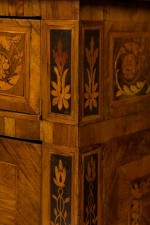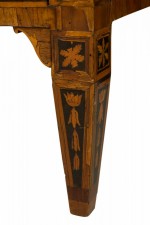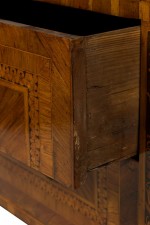FRANCESCO PREDA Italian Neo-Class Walnut and Lemonwood Inlaid Commode / Chest
$52,500 (USD)
Available Qty: 1
Item #: REG5015
Italian Neo-Classic (Milanese) walnut and lemonwood 3-drawer commode / chest with ornate inlaid patterns along the borders and sides with a central inlaid pastoral scene on the drawer fronts, each mounted with bronze bow knot and wreath design drawer pulls, resting on four tapered legs. (Attributed to FRANCESCO PREDA).
Ships from:
Newel Gallery
306 East 61st Street, 3rd Floor
NY - 10065
Taxes may apply.
Learn more
See it in Person
Call (212) 758-1970 or Email Us
FRANCESCO PREDA Italian Neo-Class Walnut and Lemonwood Inlaid Commode / Chest
Need Assistance?
Call us at 212-758-1970 for assistance With made to order items
Special Order Terms & Conditions
50% due on approval. 50% upon completion Of production. Please refer to Newel's company policies
INQUIRE
PLEASE FILL IN THE REQUIRED FIELDS.
X
FRANCESCO PREDA Italian Neo-Class Walnut and Lemonwood Inlaid Commode / Chest
Italian Neo-Classic (Milanese) walnut and lemonwood 3-drawer commode / chest with ornate inlaid patterns along the borders and sides with a central inlaid pastoral scene on the drawer fronts, each mounted with bronze bow knot and wreath design drawer pulls, resting on four tapered legs. (Attributed to FRANCESCO PREDA)
DETAILS
Sku:
REG5015
Ships From:
New York, NY
Creator:
Giuseppe Maggiolini
DIMENSIONS (INCHES)
Width:
52.0"
Height:
35.0"
Depth :
22.0"
INFO
Style:
Italian
Materials & Techniques:
Bronze, fruitwood, inlaid, metal, walnut, wood
Category:
Tables, Cabinets & Case Goods, Dining Room
Condition:
Minor losses to veneer, missing keys, top and bottom drawers are locked shut.
Good; Minor losses

About Giuseppe Maggiolini
Giuseppe Maggiolini (1738-1814) was an Italian furniture designer and decorative arts artist known for his exquisite craftsmanship and intricate designs. He was born in Milan, Italy, and showed an early interest in woodworking and design.
Maggiolini trained under the renowned furniture maker, Giuseppe Maria Bonzanigo, where he honed his skills in woodworking and gained a deep understanding of the Rococo and Neoclassical styles. Inspired by the works of influential designers such as Thomas Chippendale and Jean-Henri Riesener, Maggiolini developed his unique style that combined the elegance of the Rococo with the simplicity and geometric forms of the Neoclassical period.
Throughout his career, Maggiolini gained recognition for his attention to detail and meticulous Read Full Bio
Giuseppe Maggiolini (1738-1814) was an Italian furniture designer and decorative arts artist known for his exquisite craftsmanship and intricate designs. He was born in Milan, Italy, and showed an early interest in woodworking and design.
Maggiolini trained under the renowned furniture maker, Giuseppe Maria Bonzanigo, where he honed his skills in woodworking and gained a deep understanding of the Rococo and Neoclassical styles. Inspired by the works of influential designers such as Thomas Chippendale and Jean-Henri Riesener, Maggiolini developed his unique style that combined the elegance of the Rococo with the simplicity and geometric forms of the Neoclassical period.
Throughout his career, Maggiolini gained recognition for his attention to detail and meticulous craftsmanship. He was known for incorporating intricate marquetry, delicate inlays, and ornate carvings into his furniture pieces. His designs often featured floral motifs, classical figures, and architectural elements, showcasing his mastery of both form and function.
Maggiolini's work was highly sought after by the European nobility and aristocracy. He received numerous commissions from prominent figures, including Empress Maria Theresa of Austria and King Louis XVI of France. His furniture pieces adorned the palaces and residences of the elite, adding a touch of luxury and sophistication to their interiors.
In addition to furniture, Maggiolini also excelled in other decorative arts, such as creating stunning marquetry panels, gilded mirrors, and intricate clock cases. His ability to seamlessly blend different materials and techniques made him a versatile artist in the world of decorative arts.
Despite his success, Maggiolini faced challenges during the turbulent times of the French Revolution and the subsequent Napoleonic Wars. The political instability in Europe affected the demand for luxury furniture, leading to a decline in his commissions. However, Maggiolini adapted to the changing times by creating smaller, more affordable pieces that appealed to a wider market.
Giuseppe Maggiolini's legacy lives on through his exquisite craftsmanship and innovative designs. His furniture pieces can be found in prestigious museums and private collections worldwide, showcasing his significant contribution to the field of furniture and decorative arts. His ability to blend different styles and techniques continues to inspire contemporary designers and artists in their pursuit of creating timeless and elegant pieces.
more works by Giuseppe Maggiolini
FRANCESCO PREDA Italian Neo-Class Walnut and Lemonwood Inlaid Commode / Chest
$52,500
(USD)
QTY: 1
#REG5015
Width: 52"
Depth: 22"
Height: 35"
Save to project
Italian Neo-Classic Inlaid Marquetry Single Drawer Centre Table
$35,000
(USD)
QTY: 1
#REG5394
Width: 47"
Depth: 23.5"
Height: 32.25"
Save to project
Italian Neo-Classic Inlaid Marquetry Single Drawer Centre Table
$35,000
(USD)
QTY: 1
#REG5394
Width: 47"
Depth: 23.5"
Height: 32.25"
Save to project
Italian Neo-Classic Inlaid Marquetry Single Drawer Centre Table
$35,000
(USD)
QTY: 1
#REG5394
Width: 47"
Depth: 23.5"
Height: 32.25"
Save to project
Italian Neo-Classic Inlaid Marquetry Single Drawer Centre Table
$35,000
(USD)
QTY: 1
#REG5394
Width: 47"
Depth: 23.5"
Height: 32.25"
Save to project
Italian Neo-Classic Inlaid Marquetry Single Drawer Centre Table
$35,000
(USD)
QTY: 1
#REG5394
Width: 47"
Depth: 23.5"
Height: 32.25"
Save to project
Italian Neo-Classic Inlaid Marquetry Single Drawer Centre Table
$35,000
(USD)
QTY: 1
#REG5394
Width: 47"
Depth: 23.5"
Height: 32.25"
Save to project
Italian Neo-Classic Inlaid Marquetry Single Drawer Centre Table
$35,000
(USD)
QTY: 1
#REG5394
Width: 47"
Depth: 23.5"
Height: 32.25"
Save to project
FRANCESCO PREDA Italian Neo-Class Walnut and Lemonwood Inlaid Commode / Chest
$52,500
(USD)
QTY: 1
#REG5015
Width: 52"
Depth: 22"
Height: 35"
Save to project
Italian Neo-Classic Inlaid Marquetry Single Drawer Centre Table
$35,000
(USD)
QTY: 1
#REG5394
Width: 47"
Depth: 23.5"
Height: 32.25"
Save to project
FRANCESCO PREDA Italian Neo-Class Walnut and Lemonwood Inlaid Commode / Chest
$52,500
(USD)
QTY: 1
#REG5015
Width: 52"
Depth: 22"
Height: 35"
Save to project
Italian Neo-Classic Inlaid Marquetry Single Drawer Centre Table
$35,000
(USD)
QTY: 1
#REG5394
Width: 47"
Depth: 23.5"
Height: 32.25"
Save to project
FRANCESCO PREDA Italian Neo-Class Walnut and Lemonwood Inlaid Commode / Chest
$52,500
(USD)
QTY: 1
#REG5015
Width: 52"
Depth: 22"
Height: 35"
Save to project
Italian Neo-Classic Inlaid Marquetry Single Drawer Centre Table
$35,000
(USD)
QTY: 1
#REG5394
Width: 47"
Depth: 23.5"
Height: 32.25"
Save to project
related items
Italian Neoclassic Painted an Parcel-Gilt Two-Drawer Commode, Piedmontese
$9,000
(USD)
QTY: 1
#REG5093
Width: 46"
Depth: 20"
Height: 34"
Save to project
Pair of Swedish Neo-Classic Cream Painted and Gilt Demilune Wall-Mounted Console Tables
$9,850
/ Pair (USD)
QTY: 2
#REG4102
Width: 23"
Depth: 14"
Height: 29"
Save to project
Pair of Italian Neo-Classic Cream Painted, Parcel-Gilt and Carved Wall-Mounted Console Tables
$25,000
/ Pair (USD)
QTY: 2
#REG4012
Width: 45.5"
Depth: 21"
Height: 35"
Save to project
Maggiolini Italian Neo-Classical Inliad Marquetry 3-Drawer Commode
$49,500
(USD)
QTY: 1
#NWL6789
Width: 48"
Depth: 24"
Height: 35.5"
Save to project
Neo-Classic Style White Distressed Wood and Green Faux Marble Topped Console Table
$6,750
(USD)
QTY: 1
#NWL2467
Width: 59"
Depth: 27"
Height: 32"
Save to project
Pair of Swedish Neo-Classic Cream Painted and Gilt Demilune Wall-Mounted Console Tables
$9,850
/ Pair (USD)
QTY: 2
#REG4102
Width: 23"
Depth: 14"
Height: 29"
Save to project
Pair of Italian Neo-Classic Cream Painted, Parcel-Gilt and Carved Wall-Mounted Console Tables
$25,000
/ Pair (USD)
QTY: 2
#REG4012
Width: 45.5"
Depth: 21"
Height: 35"
Save to project
Pair of Swedish Neo-Classic Cream Painted and Gilt Demilune Wall-Mounted Console Tables
$9,850
/ Pair (USD)
QTY: 2
#REG4102
Width: 23"
Depth: 14"
Height: 29"
Save to project
Pair of Italian Neo-Classic Cream Painted, Parcel-Gilt and Carved Wall-Mounted Console Tables
$25,000
/ Pair (USD)
QTY: 2
#REG4012
Width: 45.5"
Depth: 21"
Height: 35"
Save to project
Maggiolini Italian Neo-Classical Inliad Marquetry 3-Drawer Commode
$49,500
(USD)
QTY: 1
#NWL6789
Width: 48"
Depth: 24"
Height: 35.5"
Save to project
Neo-Classic Style White Distressed Wood and Green Faux Marble Topped Console Table
$6,750
(USD)
QTY: 1
#NWL2467
Width: 59"
Depth: 27"
Height: 32"
Save to project
Italian Neoclassic Painted an Parcel-Gilt Two-Drawer Commode, Piedmontese
$9,000
(USD)
QTY: 1
#REG5093
Width: 46"
Depth: 20"
Height: 34"
Save to project
Pair of Swedish Neo-Classic Cream Painted and Gilt Demilune Wall-Mounted Console Tables
$9,850
/ Pair (USD)
QTY: 2
#REG4102
Width: 23"
Depth: 14"
Height: 29"
Save to project
Pair of Italian Neo-Classic Cream Painted, Parcel-Gilt and Carved Wall-Mounted Console Tables
$25,000
/ Pair (USD)
QTY: 2
#REG4012
Width: 45.5"
Depth: 21"
Height: 35"
Save to project
Pair of Italian Neo-Classic Cream Painted, Parcel-Gilt and Carved Wall-Mounted Console Tables
$25,000
/ Pair (USD)
QTY: 2
#REG4012
Width: 45.5"
Depth: 21"
Height: 35"
Save to project
Maggiolini Italian Neo-Classical Inliad Marquetry 3-Drawer Commode
$49,500
(USD)
QTY: 1
#NWL6789
Width: 48"
Depth: 24"
Height: 35.5"
Save to project
Neo-Classic Style White Distressed Wood and Green Faux Marble Topped Console Table
$6,750
(USD)
QTY: 1
#NWL2467
Width: 59"
Depth: 27"
Height: 32"
Save to project
Italian Neoclassic Painted an Parcel-Gilt Two-Drawer Commode, Piedmontese
$9,000
(USD)
QTY: 1
#REG5093
Width: 46"
Depth: 20"
Height: 34"
Save to project
Pair of Swedish Neo-Classic Cream Painted and Gilt Demilune Wall-Mounted Console Tables
$9,850
/ Pair (USD)
QTY: 2
#REG4102
Width: 23"
Depth: 14"
Height: 29"
Save to project
Pair of Italian Neo-Classic Cream Painted, Parcel-Gilt and Carved Wall-Mounted Console Tables
$25,000
/ Pair (USD)
QTY: 2
#REG4012
Width: 45.5"
Depth: 21"
Height: 35"
Save to project
Maggiolini Italian Neo-Classical Inliad Marquetry 3-Drawer Commode
$49,500
(USD)
QTY: 1
#NWL6789
Width: 48"
Depth: 24"
Height: 35.5"
Save to project
Maggiolini Italian Neo-Classical Inliad Marquetry 3-Drawer Commode
$49,500
(USD)
QTY: 1
#NWL6789
Width: 48"
Depth: 24"
Height: 35.5"
Save to project
Neo-Classic Style White Distressed Wood and Green Faux Marble Topped Console Table
$6,750
(USD)
QTY: 1
#NWL2467
Width: 59"
Depth: 27"
Height: 32"
Save to project
Italian Neoclassic Painted an Parcel-Gilt Two-Drawer Commode, Piedmontese
$9,000
(USD)
QTY: 1
#REG5093
Width: 46"
Depth: 20"
Height: 34"
Save to project
Pair of Swedish Neo-Classic Cream Painted and Gilt Demilune Wall-Mounted Console Tables
$9,850
/ Pair (USD)
QTY: 2
#REG4102
Width: 23"
Depth: 14"
Height: 29"
Save to project
Pair of Italian Neo-Classic Cream Painted, Parcel-Gilt and Carved Wall-Mounted Console Tables
$25,000
/ Pair (USD)
QTY: 2
#REG4012
Width: 45.5"
Depth: 21"
Height: 35"
Save to project
Maggiolini Italian Neo-Classical Inliad Marquetry 3-Drawer Commode
$49,500
(USD)
QTY: 1
#NWL6789
Width: 48"
Depth: 24"
Height: 35.5"
Save to project
Neo-Classic Style White Distressed Wood and Green Faux Marble Topped Console Table
$6,750
(USD)
QTY: 1
#NWL2467
Width: 59"
Depth: 27"
Height: 32"
Save to project
Neo-Classic Style White Distressed Wood and Green Faux Marble Topped Console Table
$6,750
(USD)
QTY: 1
#NWL2467
Width: 59"
Depth: 27"
Height: 32"
Save to project
Italian Neoclassic Painted an Parcel-Gilt Two-Drawer Commode, Piedmontese
$9,000
(USD)
QTY: 1
#REG5093
Width: 46"
Depth: 20"
Height: 34"
Save to project
Pair of Swedish Neo-Classic Cream Painted and Gilt Demilune Wall-Mounted Console Tables
$9,850
/ Pair (USD)
QTY: 2
#REG4102
Width: 23"
Depth: 14"
Height: 29"
Save to project
Pair of Italian Neo-Classic Cream Painted, Parcel-Gilt and Carved Wall-Mounted Console Tables
$25,000
/ Pair (USD)
QTY: 2
#REG4012
Width: 45.5"
Depth: 21"
Height: 35"
Save to project
Maggiolini Italian Neo-Classical Inliad Marquetry 3-Drawer Commode
$49,500
(USD)
QTY: 1
#NWL6789
Width: 48"
Depth: 24"
Height: 35.5"
Save to project
Neo-Classic Style White Distressed Wood and Green Faux Marble Topped Console Table
$6,750
(USD)
QTY: 1
#NWL2467
Width: 59"
Depth: 27"
Height: 32"
Save to project
Italian Neoclassic Painted an Parcel-Gilt Two-Drawer Commode, Piedmontese
$9,000
(USD)
QTY: 1
#REG5093
Width: 46"
Depth: 20"
Height: 34"























